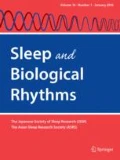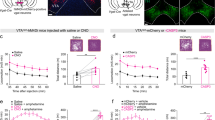Abstract
Economo observed in 1930 that many cases of lethargy begin with a severe insomnia and fever followed by a long-lasting hypersomnia. We confirmed this evidence in animal cases where chemical lesions of the preoptic region resulted in severe insomnia accompanied with fever. Moreover, a subsequent pharmacological inhibition of neuronal activity of the posterior ventrolateral hypothalamus caused transient hypersomnia in these insomniac animals. However, vigilance states of the experimental animals returned to normal after several weeks, suggesting that the irreversible Economo’s lethargy may be due to the damage of passing fibers in the ventral hypothalamus. Similarly, chemical lesions of neurons of the midbrain reticular formation did not induce coma nor hypersomnia, which is inconsistent with lesion studies reported by Lindsley et al. using electrolytic coagulation. This fact further supports the importance of passing fibers in the midbrain. In addition, Mauthner in 1890 observed hypersomnia and abnormal eye movements in lethargic patients infected by “nona”, suggesting the implication of the periaqueductal gray in the vicinity of the 3rd nerve. We confirmed this hypothesis: hypersomnia was accompanied by a significant increase in REM sleep after chemical inactivation of a small part of the ventrolateral periaqueductal gray and dorsal portion of the subjacent reticular formation. On the other hand, removal of the tele- and di-encephalon caused an irreversible coma and abolished the daily rhythm of REM. This state of sleep is also regulated by forebrain structures and internal clocks in the suprachiasmatic nucleus.
Similar content being viewed by others
References
Gayet A. Affection encéphalique (encéphale diffuse probable) localisée aux étages supérieurs des péduncules cérébraux et aux couches optiques ainsi qu’au plancher du quatrième ventricule. Arch. Physiol. Norm. Path. 1875; 2: 341–51.
Soca F. Sur un cas de sommeil prolongé pendant sept mois par tumeur de l’hypophyse. Nouvelle iconographie de la Salpétrière 1900; 3: 101–15.
Ranson S, Magoun H. The hypothalamus 17. Ergeb. Physiol. 1939; 41: 56–163.
Mauthner L. Zur Pathologie und Phygiologie der Schlafes nebust Bemerlungen uber die nona. Wien. Med. Wschr. 1890; 23: 961–4. 24: 1001–4; 25: 1049–52; 26: 1092–5; 27: 1143–6; 28: 1185–8.
Economo CV. Schlaftheorie 9. Ergeb. Physiol. 1929; 28 312–39.
Nauta W. Hypothalamic regulation of sleep in rats. An experimental study. J. Neurophysiol. 1946; 9: 285–316.
Moruzzi G, Magoun HW. Brain Reticular formation and activation of the EEG Electroencephalogr. Clin. Neurophysiol. 1949; 1: 1–165.
Bremer F. L’activité cérébrale au cours du sommeil et de la narcose. Contribution à l’étude du mécanisme du sommeil 3. Bull Acad. Roy. Med. Belge. 1937; 4: 68–86.
Lindsley DB, Schreiner LH, Knowles WB, Magoun HW. Behavioral and EEG changes following chronic brain stem lesions in the cat. Electroencephalogr. Clin. Neurophysiol. 1950; 2: 483–98.
Denoyer M, Sallanon M, Buda C, Kitahama K, Jouvet M. Neurotoxic lesion of the mesencephalic reticular formation and/or the posterior hypothalamus does not alter waking in the cat. Brain Res. 1991; 539: 287–303.
Jouvet M, Benoit O, Marsallon A, Courjon J. Effects of caffeine on cerebral electrical activity. C. R. Seances Soc. Biol. Fil. 1957; 151: 1542–5.
Tokizane T. Studies on the paradoxical phase of sleep in the cat. Prog. Brain Res. 1966; 21: 230–68.
Lin JS, Kitahama K, Fort P, Panula P, Denney RM, Jouvet M. Histaminergic system in the cat hypothalamus with reference to type B monoamine oxidase. J. Comp. Neurol. 1993; 330: 405–20.
Peyron C, Tighe DK, van den Pol AN et al. Neurons containing hypocretin (orexin) project to multiple neuronal systems. J. Neurosci. 1998; 18: 9996–10015.
Lin JS. Brain structures and mechanisms involved in the control of cortical activation and wakefulness, with emphasis on the posterior hypothalamus and histaminergic neurons. Sleep Med. Rev. 2000; 4: 471–503.
Nishino S. Clinical and neurobiological aspects of narcolepsy. Sleep Med. 2007; 8: 373–99.
Sallanon M, Sakai K, Buda C, Puymartin M, Jouvet M. Increase of Paradoxical Sleep induced by microinjections of iboteinic acid into the ventrolateral part of the posterior hypothalamus in the cat. Arch. Ital. Biol. 1988; 126 87–97.
Sterman MB, Clemente CD. Forebrain inhibitory mechanisms: sleep patterns induced by basal forebrain stimulation in the behaving cat. Exp. Neurol. 1962; 6: 103–17.
McGinty D, Sterman M. Sleep suppression after basal forebrain lesion in the cat 15. Science 1968; 160: 1253–5.
Sallanon M, Denoyer M, Kitahama K, Aubert C, Gay N, Jouvet M. Long-lasting insomnia induced by preoptic neuron lesions and its transient reversal by muscimol injection into the posterior hypothalamus in the cat. Neuroscience 1989; 32: 669–83.
Sallanon M, Kitahama K, Denoyer M, Gay N, Jouvet M. Insomnie de longue durée après lésion des périkaryons de l’aire préoptique paramédiane chez le chat. C. R. Acad. Sci. (III) 1986; 303: 403–9.
Urade Y, Hayaishi O. Prostaglandin D2 and sleep regulation. Biochim. Biophys. Acta 1999; 4: 606–15.
Jouvet M. Recherches sur les structures nerveuses et les mécanismes responsables des différentes phases du sommeil physiologique. Arch. Ital. Biol. 1962; 100: 125–206.
Jouvet M, Buda C, Sastre JP. [Is there a bulbar pacemaker responsible for the ultradian rhythm of paradoxical sleep?]. Arch. Ital. Biol. 1995; 134: 39–56.
Sallanon M, Buda C, Puymartin M, Denoyer M, Kitahama K, Jouvet M. Hypophysectomy does not disturb the sleep-waking cycle in the cat. Neurosci. Lett. 1988; 88: 173–8.
Sallanon M, Kitahama K, Buda C, Puymartin M, Luppi PH, Jouvet M. Effects of electrolytic lesion of hypothalamic paraventricular nucleus and its related areas on the sleep waking cycle in the cat. Arch. Ital. Biol. 1987; 125 305–15.
Luppi PH, Gervasoni D, Verret L et al. Paradoxical (REM) sleep genesis: the switch from an aminergic-cholinergic to a GABAergic-glutamatergic hypothesis. J. Physiol. Paris 2007; 100: 217–83.
Sastre JP, Buda C, Kitahama K, Jouvet M. Importance of the ventrolateral region of the periaqueductal gray in the control of paradoxical sleep as studied by muscimol microinjections in the cat. Neuroscience 1996; 74: 415–26.
Author information
Authors and Affiliations
Corresponding author
Rights and permissions
About this article
Cite this article
Kitahama, K., Luppi, PH. Insomnia, hypersomnia and coma in animal models and their clinical implications. Sleep Biol. Rhythms 9 (Suppl 1), 52–58 (2011). https://doi.org/10.1111/j.1479-8425.2010.00462.x
Accepted:
Published:
Issue Date:
DOI: https://doi.org/10.1111/j.1479-8425.2010.00462.x




